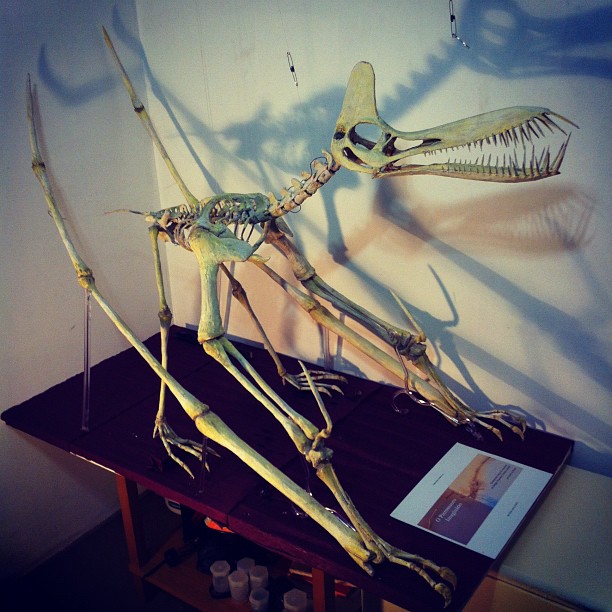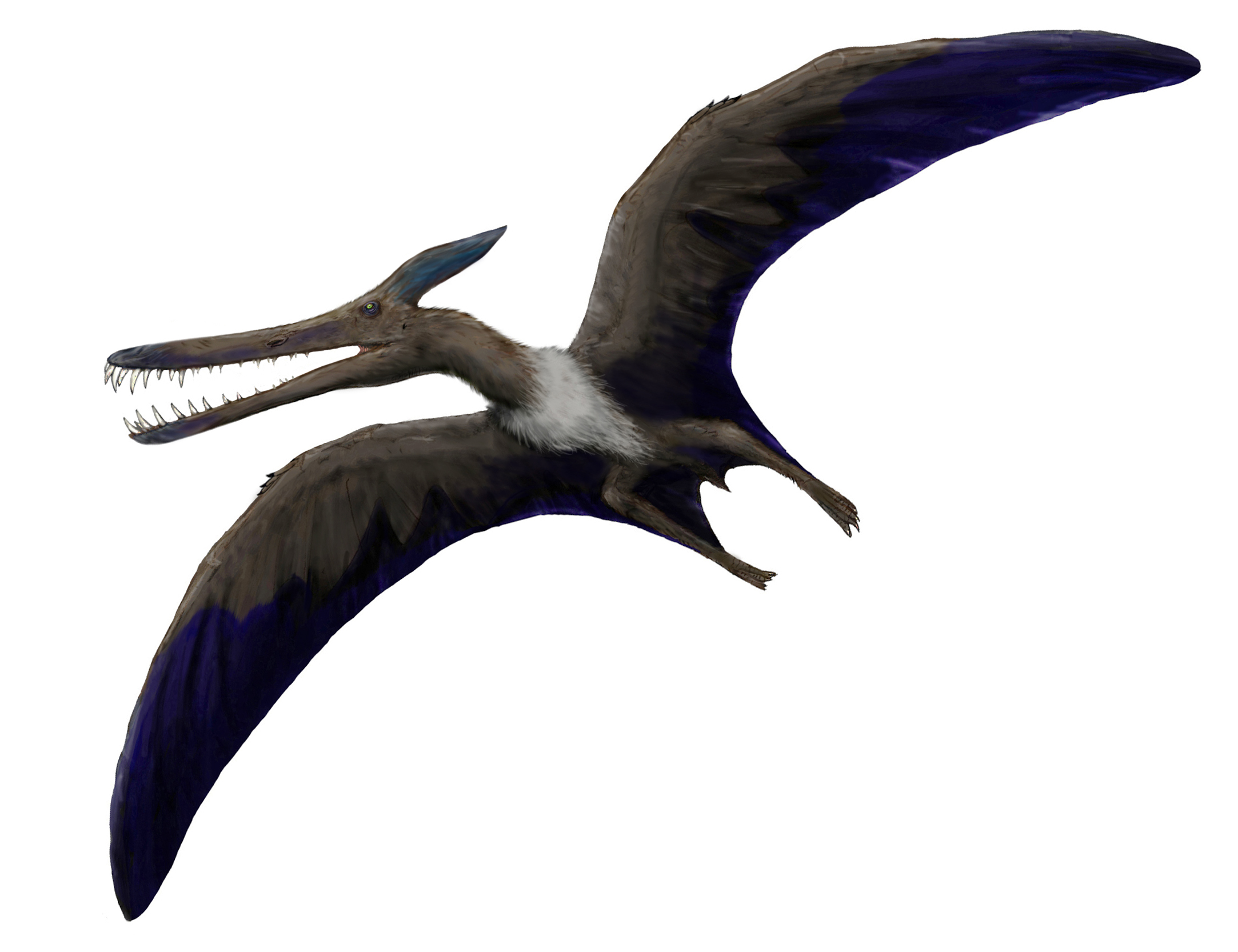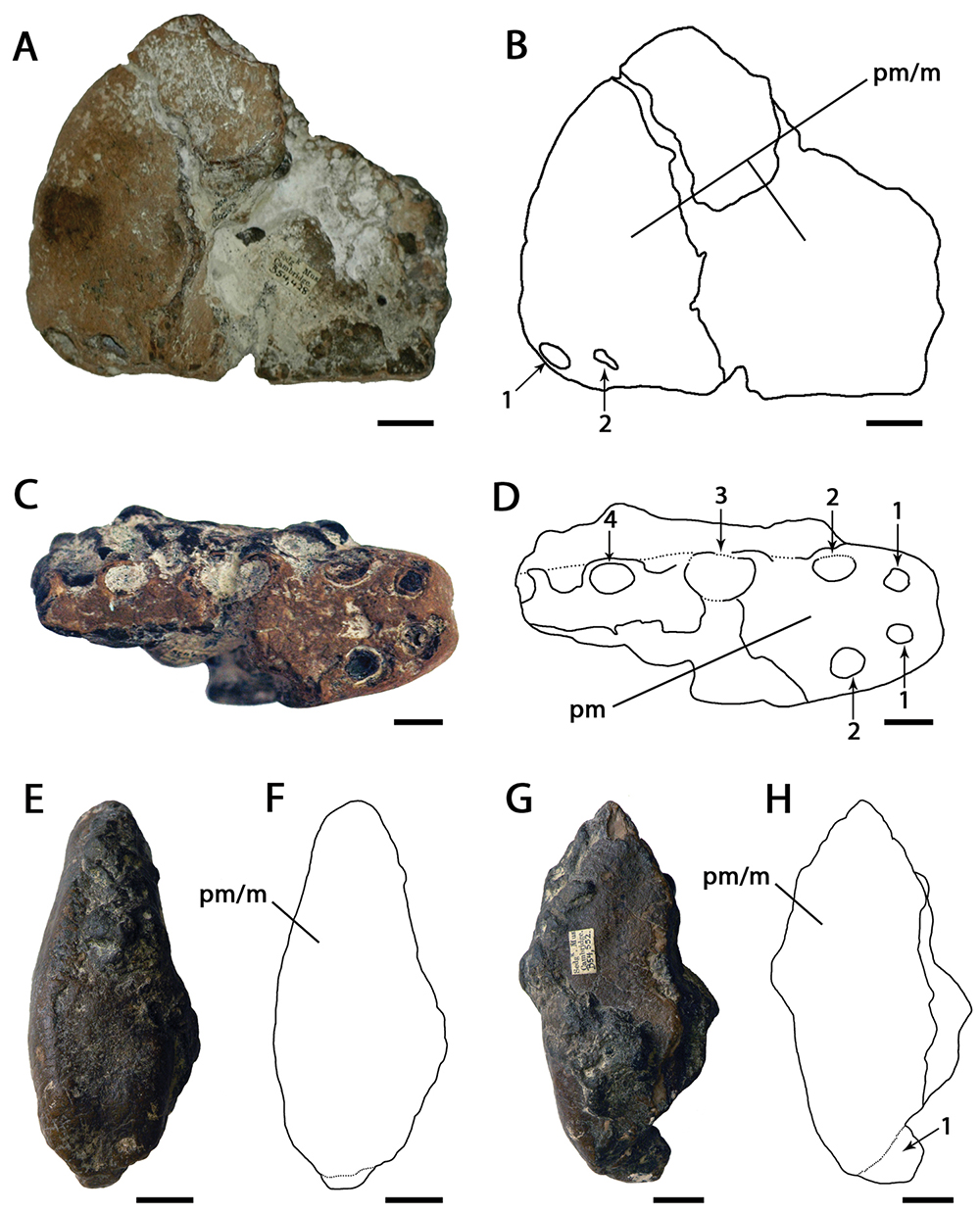|
Boreopteridae
Boreopteridae (meaning "northern wings") is a group of pterodactyloid pterosaurs from the Aptian-age Lower Cretaceous Yixian Formation of Liaoning, China. Classification In 2006, Lü Junchang and colleagues named the clade Boreopteridae for the clade containing the common ancestor of '' Boreopterus'' and '' Feilongus'' and all its descendants, which the authors reclassified as close relatives of the ornithocheirids. (''Feilongus'' had originally been considered a gallodactylid). Many possible boreopterids were subsequently described, one possible example being '' Aetodactylus'', which has been claimed to be similar to '' Boreopterus''. Originally considered close relatives of the ornithocheirids, many of these supposed boreopterids have been found to belong to other groups of the pterodactyloid lineage. In 2012, a phylogenetic analysis by Lü ''et al.'' divided the Boreopteridae into two subfamilies: Boreopterinae, comprising ''Boreopterus'' and ''Zhenyuanopterus'', and Moganop ... [...More Info...] [...Related Items...] OR: [Wikipedia] [Google] [Baidu] |
Zhenyuanopterus
''Zhenyuanopterus'' is a genus of boreopterid pterosaur which is known from Lower Cretaceous (early Aptian stage) Yixian Formation of Liaoning, China. It contains one species, ''Zhenyuanopterus longirostris'', which was first described and named by Lü Junchang. Discovery and naming ''Zhenyuanopterus longirostris'' was named by paleontologist Lü Junchang in 2005. The genus is named after Sun Zhenyuan, who gave Lü Junchang the fossils along with Zi Fan. The specific name ("long-snouted") refers to the long snout of the pterosaur. One specimen is known; a complete skeleton, it was found in the Huangbanjigou locality of the Yixian Formation, and it is catalogued as GLGMV 0001 in the Guilin Longshan Geological Museum in Guangxi, China. A second, larger partial specimen, consisting of the rear half of the body, was found at the same locality and catalogued as XHPM1088 at the Dalian Xinghai Paleontological Museum. In 2014, Teng Fangfang and colleagues described it. Description ... [...More Info...] [...Related Items...] OR: [Wikipedia] [Google] [Baidu] |
Boreopterus Cuiae
''Boreopterus'' is a genus of boreopterid pterodactyloid pterosaur from the Barremian-Aptian-age Lower Cretaceous Yixian Formation of Dalian, Liaoning, China. Etymology ''Boreopterus'' was named in 2005 by Lü Junchang and Ji Qiang. The type species is ''Boreopterus cuiae''. The genus name is derived from Greek ''boreios'', "northern" and ''pteron'', "wing". The specific epithet honors Cui Xu. Description ''Boreopterus'' is based on holotype JZMP-04-07-3, a nearly complete but crushed skeleton and skull. The skull is 235 millimeters long (9.25 inches), low and elongated with a rounded tip. Its wingspan is estimated to have been around 1.45 meters (4.76 feet). Its teeth, especially the anterior nine pairs, are quite large, forming a mesh of sharp teeth at the front of the mouth; the third and fourth teeth from the front are the largest. There are at least 27 teeth in each side of both the upper and lower jaws, which is a large amount. Classification Lü and ... [...More Info...] [...Related Items...] OR: [Wikipedia] [Google] [Baidu] |
Boreopterus
''Boreopterus'' is a genus of boreopterid pterodactyloid pterosaur from the Barremian-Aptian-age Lower Cretaceous Yixian Formation of Dalian, Liaoning, China. Etymology ''Boreopterus'' was named in 2005 by Lü Junchang and Ji Qiang. The type species is ''Boreopterus cuiae''. The genus name is derived from Greek ''boreios'', "northern" and ''pteron'', "wing". The specific epithet honors Cui Xu. Description ''Boreopterus'' is based on holotype JZMP-04-07-3, a nearly complete but crushed skeleton and skull. The skull is 235 millimeters long (9.25 inches), low and elongated with a rounded tip. Its wingspan is estimated to have been around 1.45 meters (4.76 feet). Its teeth, especially the anterior nine pairs, are quite large, forming a mesh of sharp teeth at the front of the mouth; the third and fourth teeth from the front are the largest. There are at least 27 teeth in each side of both the upper and lower jaws, which is a large amount. Classification Lü and ... [...More Info...] [...Related Items...] OR: [Wikipedia] [Google] [Baidu] |
Ornithocheiromorpha
Ornithocheiromorpha (from Ancient Greek, meaning "bird hand form") is a group of pterosaurs within the suborder Pterodactyloidea. Fossil remains of this group date back from the Early to Late Cretaceous periods (Valanginian to Turonian stages), around 140 to 92.5 million years ago. Ornithocheiromorphs were discovered worldwide except Antarctica, though most genera were recovered in Europe, Asia and South America. They were the most diverse and successful pterosaurs during the Early Cretaceous, but throughout the Late Cretaceous they were replaced by better adapted and more advanced pterosaur species such the pteranodontids and azhdarchoids. The Ornithocheiromorpha was defined in 2014 by Andres and colleagues, and they made Ornithocheiromorpha the most inclusive clade containing ''Ornithocheirus'', but not ''Pteranodon''. Ornithocheiromorphs are considered to be some of the largest animals to have ever flown. Members of this group are also regarded to have some of the largest ... [...More Info...] [...Related Items...] OR: [Wikipedia] [Google] [Baidu] |
Moganopterus
''Moganopterus'' is an extinct genus of ctenochasmatid pterosaur from the Early Cretaceous of western Liaoning Province, China. Discovery and naming The fossil of ''Moganopterus'' was discovered at the village of Xiaosanjiazi near the town of Lamadong in Liaoning Province. In 2012 it was named and described by Lü Junchang, Pu Hanyong, Xu Li, Wu Yanhua and Wei Xuefang as the type species ''Moganopterus zhuiana''. The generic name is derived from the legendary sword couple Gan Jiang and Mo Ye, in reference to the blade-like jaws, and a Latinized Greek πτερόν, ''pteron'', "wing". The specific name honors Ms. Zhu Haifen, who made the specimen available to science. The holotype, 41HIII0419, was uncovered in a layer of the Yixian Formation, dating from the Aptian, about 125 million years old. It consists of an almost complete skull with lower jaws and the second to fourth neck vertebrae. The fossil is compressed on a slab and counterslab, the splitting of the two plates h ... [...More Info...] [...Related Items...] OR: [Wikipedia] [Google] [Baidu] |
Lonchodraco
''Lonchodraco'' is a genus of lonchodraconid pterodactyloid pterosaur from the Late Cretaceous of southern England. The genus includes species that were previously assigned to other genera. Discovery and naming In 1846, James Scott Bowerbank named and described some remains found in a chalk pit at Burham near Maidstone in Kent, as a new species of ''Pterodactylus'': ''Pterodactylus giganteus''. The specific name means "the gigantic one" in Latin. The same pit generated remains of '' Pterodactylus cuvieri''. In 1848, Bowerbank published a histological study of the bone structure of ''P. giganteus''. At the time, the British Association Code of 1843 allowed to change names if they were inappropriate. In 1850, Richard Owen, considering the species not to have been particularly large, and renamed it into ''Pterodactylus conirostris''; the specific name meaning "cone-snouted", which was based on the conical snout of specimen NHMUK PV 39412. However, after insistent objections by ... [...More Info...] [...Related Items...] OR: [Wikipedia] [Google] [Baidu] |
Guidraco
''Guidraco'' (Chin. ''gui'' (鬼) "malicious ghost" + Lat. ''draco'' "dragon") is an extinct genus of toothed pterodactyloid pterosaur known from the Early Cretaceous of Liaoning Province, northeast China. According to many recent studies, ''Guidraco'' is a member of the group Anhanguerinae, a subfamily belonging to the larger group Anhangueridae. Discovery ''Guidraco'' is known only from the holotype IVPP V17083, an articulated partial skeleton consisting of a nearly complete skull, lower jaws and a series of four, second to fifth, cervical vertebrae. It was collected at Sihedang near Lingyuan City in the Liaoning Province from the Jiufotang Formation, dating to the Aptian stage of the Early Cretaceous, about 120 million years ago. Etymology ''Guidraco'' was first described and named by Wang Xiaolin, Alexander W.A. Kellner, Jiang Shunxing and Cheng Xin in 2012 and the type species is ''Guidraco venator''. The generic name is derived from Chinese ''gui'' (鬼), ... [...More Info...] [...Related Items...] OR: [Wikipedia] [Google] [Baidu] |
Gallodactylid
Gallodactylidae is a group of pterosaurs within the suborder Pterodactyloidea. Gallodactylids differed from other related pterosaurs in several distinct features, including fewer than 50 teeth present only in the jaw tips, and rounded crests present on the rear portion of the skull and jaws but not near the ends of their snouts. At least some species possessed jaw flanges, possibly used to bissect hard-shelled prey. History Gallodactylidae was named to contain '' Gallodactylus'' (now usually considered a synonym of ''Cycnorhamphus'') and its closest relatives. Many subsequent studies, however, showed that ''Gallodactylus'' did not form a clade with any non-synonymous pterosaurs that were not themselves part of a different family, and so the name was often ignored. The name returned to common use with the discovery of ''Gladocephaloideus'', a Chinese pterosaur species that shared many similarities with ''Cycnorhamphus''. Among other features, the Gallodactylidae was distinguished ... [...More Info...] [...Related Items...] OR: [Wikipedia] [Google] [Baidu] |
Lonchodectidae
Lonchodectidae or LonchodraconidaePêgas, R.V., Holgado, B., Leal, M.E.C., 2019. "''Targaryendraco wiedenrothi'' gen. nov. (Pterodactyloidea, Pteranodontoidea, Lanceodontia) and recognition of a new cosmopolitan lineage of Cretaceous toothed pterodactyloids", ''Historical Biology'', 1–15. doi:10.1080/08912963.2019.1690482 is a group of pterosaurs within the clade Pterodactyloidea. It has variously been considered to be within Ctenochasmatoidea, Azhdarchoidea and Pteranodontia.Witton, M.P., Martill, D.M., and Green, M. (2009). "On pterodactyloid diversity in the British Wealden (Lower Cretaceous) and a reappraisal of “Palaeornis” ''cliftii'' Mantell, 1844." ''Cretaceous Research'', 30: 676–686. They are notable for their high, conical tooth sockets and raised alveolar margins. Taxonomic history Lonchodectidae was first named by paleontologist Reginald Walter Hooley in 1914, and was first considered to only contain species of '' Lonchodectes''.Unwin, David M. 2001. "An ... [...More Info...] [...Related Items...] OR: [Wikipedia] [Google] [Baidu] |
Ludodactylus
''Ludodactylus'' (meaning "play finger") is a genus of anhanguerid pterodactyloid pterosaur from the Early Cretaceous period (Aptian stage) of what is now the Crato Formation of the Araripe Basin in Ceará, Brazil. The type and only species is ''L. sibbicki''. The generic name ''Ludodactylus'' refers to the fact that the animal had the combination of teeth and a ''Pteranodon''-like head crest, similar to many toy pterosaurs, and no such creature was known to exist until the discovery of ''Ludodactylus''. However, ''Ludodactylus'' is not the only pterosaur known to possess these features, its very close relative ''Caulkicephalus'' is another example. Etymology The genus was named by Eberhard Frey ''et al.'' in 2003 and contains one known species, ''Ludodactylus sibbicki''. The name is derived from Latin ''ludus'', "play" and Greek ''daktylos'', "finger". ''Ludus'' refers to the fact, long lamented by paleontologists, that many toy pterosaurs combined teeth with a ''Pteranodon ... [...More Info...] [...Related Items...] OR: [Wikipedia] [Google] [Baidu] |
Feilongus
''Feilongus'' is an extinct genus of ctenochasmatid pterodactyloid pterosaur from the Barremian–Aptian-age Lower Cretaceous Yixian Formation of Beipiao, Liaoning, China. Discovery and naming The genus was named and described in 2005 by Wang Xiaolin, Alexander Kellner, Zhou Zhonghe and Diogenes de Almeida Campos. The type species is ''Feilongus youngi''. The genus name is derived from ''Feilong (mythology), Feilong'', the "flying dragon". The specific name (zoology), specific name honors the Chinese paleontologist Yang Zhongjian (C. C. Young). ''Feilongus'' is based on holotype Institute of Vertebrate Paleontology and Paleoanthropology, IVPP V-12539, a skull and articulated mandible, with on the same plate the detached posterior braincase, of a subadult individual. The fossil is strongly crushed. In 2014, a second specimen, DNMHM D3068 found at Gonggao, was referred to a ''Feilongus'' sp. It consists of a skull with lower jaws and four neck vertebrae. It was a possible subadu ... [...More Info...] [...Related Items...] OR: [Wikipedia] [Google] [Baidu] |
Ornithocheiridae
Ornithocheiridae (or ornithocheirids, meaning "bird hands") is a group of pterosaurs within the suborder Pterodactyloidea. These pterosaurs were among the last to possess teeth. Members that belong to this group lived from the Early to Late Cretaceous periods (Valanginian to Turonian stages), around 140 to 90 million years ago. Ornithocheirids are generally infamous for having an enormously controversial and very confusing taxonomy. Although agreements that these animals were related, and therefore similar to istiodactylids and pteranodontians, there is still no virtual consensus over the exact content and interrelationships of this group. Ornithocheirids were the most successful pterosaurs during their reign, they were also the largest pterosaurs before the appearance of the azhdarchids such as ''Quetzalcoatlus''. Ornithocheirids were excellent fish hunters, they used various flight techniques to catch their prey, and they are also capable of flying great distances without ... [...More Info...] [...Related Items...] OR: [Wikipedia] [Google] [Baidu] |








